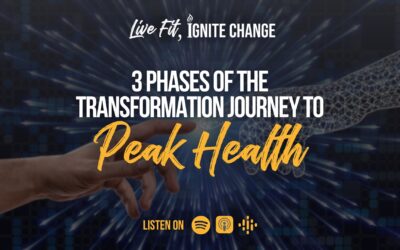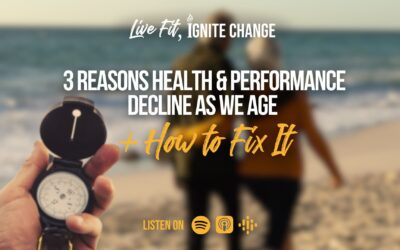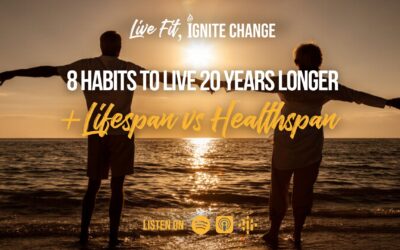In the pursuit of not just living longer but living better, we look at 5 metrics that we call the 5 x 50 by 50.
5 metrics where you want a score above or below 50 by the age 50 (and the numbers vary based on your age, if you are under or over age 50).
When you hit these 5, you are in the top 5% level of overall fitness for your age on the planet, and thus have put yourself in the best position to not only increase your lifespan (how long you live), but also your healthspan (how long you live in good health with a good quality of life), and therefore, you have a significant reduction in risk of all-cause mortality.
These 5 key metrics are not only indicators of your current health, but also powerful predictors of your longevity and healthspan. Let’s delve into each metric, understanding why they matter and how to measure them.
For Cardiovascular Fitness:
1. Resting Heart Rate (RHR) < 50 bpm (beats per minute)
- Why it Matters: A lower RHR indicates cardiovascular efficiency and a well-conditioned heart. Studies link lower RHR to a reduced risk of heart disease and overall mortality.
- How to Test: Use a wearable, such as an Oura Ring, Whoop, Apple Watch or similar device to test your resting heart rate while you sleep. If you don’t have a device, you can measure your pulse at rest for 60 seconds.
Note: You can use the below chart for daytime resting heart rates for a general idea on the variations by age and gender to adjust the goal accordingly, yet your heart rate will typically be about 20% lower while sleeping, so that’s where the trackers come in to report on your lowest heart rate, and how you can aim to be under 50 bpm while sleeping.
Resting Heart Rate for Men
| Age | 18-25 | 26-35 | 36-45 | 46-55 | 56-65 | 65+ |
| Athlete | 49-55 | 49-54 | 50-56 | 50-57 | 51-56 | 50-55 |
| Excellent | 56-61 | 55-61 | 57-62 | 58-63 | 57-61 | 56-61 |
| Good | 62-65 | 62-65 | 63-66 | 64-67 | 62-67 | 62-65 |
| Above Average | 66-69 | 66-70 | 67-70 | 68-71 | 68-71 | 66-69 |
| Average | 70-73 | 71-74 | 71-75 | 72-76 | 72-75 | 70-73 |
| Below Average | 74-81 | 75-81 | 76-82 | 77-83 | 76-81 | 74-79 |
| Poor | 82+ | 82+ | 83+ | 84+ | 82+ | 80+ |
Resting Heart Rate for Women
| Age | 18-25 | 26-35 | 36-45 | 46-55 | 56-65 | 65+ |
| Athlete | 54-60 | 54-59 | 54-59 | 54-60 | 54-59 | 54-59 |
| Excellent | 61-65 | 60-64 | 60-64 | 61-65 | 60-64 | 60-64 |
| Good | 66-69 | 65-68 | 65-69 | 66-69 | 65-68 | 65-68 |
| Above Average | 70-73 | 69-72 | 70-73 | 70-73 | 69-73 | 69-72 |
| Average | 74-78 | 73-76 | 74-78 | 74-77 | 74-77 | 73-76 |
| Below Average | 79-84 | 77-82 | 79-84 | 78-83 | 78-83 | 77-84 |
| Poor | 85+ | 85+ | 85+ | 84+ | 84+ | 84+ |
2. VO2 Max > 50 ml/kg/min (milliliters per kilogram per minute)
- Why it Matters: VO2 Max reflects your body’s ability to use oxygen during intense exercise. High levels correlate with better cardiovascular health and endurance.
- How to Test: The most accurate way to test this is in a medical lab or sports medicine facility, but if you don’t have access to those, you have other options. Some wearable fitness trackers estimate VO2 max. A quick online search will reveal dozens of VO2 max calculators. One simple online VO2 max calculator was created by the Norwegian Institute of Science and Technology (NTNU). Another simple way to test VO2 max is via the Cooper 12-Minute Run Test, to see how far you can run in 12 minutes. To calculate your estimated VO2 Max results, use either of these formulas:
Kilometers: VO2max = (22.351 x kilometers) – 11.288
Miles: VO2max = (35.97 x miles) – 11.291
The easiest way to get your test results (your VO2 max score) and compare yourself with others of your age and gender is with an online 12-minute test results calculator. For example, a 7-minute mile pace would equate to 1.714 miles in 12 minutes, or an estimate VO2max of 50.36. See the chart below for how the numbers vary by age, with the goal to start moving your VO2 max in the right direction, ideally toward the 95th percentile for age and gender.Disclaimer: If you have not been training, please do not go out and run as fast as you can. Of course, always make sure you are properly warmed-up, and check with your doctor before starting any fitness program.
VO2 Max Values by Age and Gender:
Men
| Age | 5th Percentile | 10th Percentile | 25th Percentile | 50th Percentile | 75th Percentile | 90th Percentile | 95th Percentile |
|---|---|---|---|---|---|---|---|
| 20-29 | 29.0 | 32.1 | 40.1 | 48.0 | 55.2 | 61.8 | 66.3 |
| 30-39 | 27.2 | 30.2 | 35.9 | 42.4 | 49.2 | 56.5 | 59.8 |
| 40-49 | 24.2 | 26.8 | 31.9 | 37.8 | 45.0 | 52.1 | 55.6 |
| 50-59 | 20.9 | 22.8 | 27.1 | 32.6 | 39.7 | 45.6 | 50.7 |
| 60-69 | 17.4 | 19.8 | 23.7 | 28.2 | 34.5 | 40.3 | 43.0 |
| 70-79 | 16.3 | 17.1 | 20.4 | 24.4 | 30.4 | 36.6 | 39.7 |
Women
| Age | 5th Percentile | 10th Percentile | 25th Percentile | 50th Percentile | 75th Percentile | 90th Percentile | 95th Percentile |
|---|---|---|---|---|---|---|---|
| 20-29 | 21.7 | 23.9 | 30.5 | 37.6 | 44.7 | 51.3 | 56.0 |
| 30-39 | 19.0 | 20.9 | 25.3 | 30.2 | 36.1 | 41.4 | 45.8 |
| 40-49 | 17.0 | 18.8 | 22.1 | 26.7 | 32.4 | 38.4 | 41.7 |
| 50-59 | 16.0 | 17.3 | 19.9 | 23.4 | 27.6 | 32.0 | 35.9 |
| 60-69 | 13.4 | 14.6 | 17.2 | 20.0 | 23.8 | 27.0 | 29.4 |
| 70-79 | 13.1 | 13.6 | 15.6 | 18.3 | 20.8 | 23.1 | 24.1 |
For Ability to Recover from Stress:
3. Heart Rate Variability (HRV) > 50 ms (milliseconds)
- Why it Matters: HRV indicates the adaptability of your autonomic nervous system. Higher HRV is associated with better stress management and overall health. The heart changes its rhythm with each beat. This constant variation in milliseconds between your heartbeats is known as your heart rate variability, or HRV. Linked to the autonomic nervous system (ANS), HRV acts as a mirror reflecting the balance between the rest-and-digest (parasympathetic) and fight-or-flight (sympathetic) branches. A higher HRV is associated with rest-and-digest, general fitness, and good recovery, while a lower HRV is associated with fight-or-flight responses, stress, illness, or over-training.
- How to Test: Use a heart rate monitor, wearable device and a mobile app designed for HRV measurement. These include Oura ring, Whoop, Chest straps, and some Garmin, Fitbit and Apple Watch devices.
Note: It’s worth mentioning that HRV is highly genetic, so it can be hard to move more than 50% from the baseline. It’s more helpful to follow trends for yourself than compare yourself to others, and this one is not as correlated with reduction in all-cause mortality as they others, yet it is a metric that is helpful to track and does improve when you take the steps to help your body respond favorably to stressful situations.
Average Heart Rate Variability (HRV) While Sleeping
| Age | Low | Below Average | Average | Above Average | Excellent |
| 20-29 | < 30 | 30-39 | 40-64 | 65-85 | > 85 |
| 30-39 | < 20 | 20-34 | 35-49 | 50-65 | > 65 |
| 40-49 | < 15 | 15-29 | 30-44 | 45-55 | > 55 |
| 50+ | < 15 | 15-25 | 26-39 | 40-50 | > 50 |
For Stability:
4. Balance on One Leg > 50 seconds
- Why it Matters: Balance is a key indicator of neuromuscular function and falls risk. Longer balance times correlate with better overall physical health.
- How to Test: Stand on one leg. The longer you can maintain balance, the better. Aim for at least 50 seconds.
For Strength:
5. Max Unbroken Push-ups > 50:
- Why it Matters: Upper body strength is crucial for functional independence. Studies show a correlation between push-up capacity and heart health.
- How to Test: Perform as many push-ups as you can without resting, with the goal to hit 50.
Upper Body Strength: Maximum Unbroken Push Ups
Men
| Age | Low | Below Average | Average | Above Average | Excellent |
| 20-39 | < 10 | 10-19 | 20-34 | 35-59 | > 60 |
| 40-49 | < 10 | 10-17 | 18-24 | 25-49 | > 50 |
| 50-59 | < 8 | 9-13 | 14-19 | 20-49 | > 50 |
| 60+ | < 5 | 6-9 | 10-14 | 15-39 | > 40 |
Female
| Age | Low | Below Average | Average | Above Average | Excellent |
| 20-39 | < 10 | 10-17 | 18-24 | 25-44 | > 45 |
| 40-49 | < 10 | 10-14 | 15-19 | 20-39 | > 40 |
| 50-59 | < 8 | 9-12 | 13-17 | 18-35 | > 35 |
| 60+ | < 5 | 6-9 | 10-14 | 15-29 | > 30 |
Bonus. Wall Sit > 2 minutes:
- Why it Matters: Lower body strength is just as important as upper body strength. This one just didn’t fit as the number 50 like all the others, so we added it as a bonus. Leg strength is fundamental for mobility and overall fitness. A longer wall sit time indicates strong lower body endurance.
- How to Test: Sit against a wall with knees at a 90-degree angle. Hold the position for as long as possible, aiming for over 2 minutes.
Lower Body Strength: Wall Sit (with legs at 90 degrees, in seconds)
| Low | Below Average | Average | Above Average | Excellent | |
| < 25 | 25-44 | 45-79 | 80-119 | > 120 |
Remember, these metrics are not isolated indicators but interconnected facets of comprehensive health. Aim to improve gradually and consistently, keeping in mind that personalized guidance is helpful. As you strive to meet the 5 x 50 by 50 benchmarks, you’re not just optimizing your current health — you’re investing in a longer, healthier future.
The Good News…
- Wherever you may be on these metrics now, what’s most important is that you can improve all of them.
- With the new year upon us, this is the time of year when you’re most inspired and ready to take on new routines to improve aspects of your life.
- …so there’s no better time than now. Have you heard of Dr. Peter Attia’s Centenarian Decathlon? If not, it’s simply coming up with a list of 10 things you’d like to do at 100 years old. You can get there, but to do so, you need to start training for them today.
- Each year, we’ve run our Fit Life Challenge. Each year, it gets better and better. This year, our challenge will focus on improving these 5×50 metrics, no matter if you are just getting started or if you’ve already hit 50 and would like to improve them further.
Note: These 5 metrics are lag measures (meaning the results), and thus, the challenge will focus on the lead measures (meaning, the activities that you do to drive the results, to be able to hit the goal metrics).
As we continue to state, our goal is to provide the absolute best information related to health and performance for free, including access to our Ignite Performance Blueprint. If there’s anything we can do to help you along the journey, please let us know.
Should you be interested in a more ‘concierge-level’ service to walk you through the process, it begins with a complementary health and performance assessment call, which includes an orientation to the Ignite Performance Blueprint. We’ll diagnose your current level of performance, find out where you are on these 5 metrics, see what’s holding you back, share the assessments we use, and come up with a plan for you to hit your goals. You can pick a time for your free performance assessment here.
References:
- Tanaka, H., Monahan, K. D., & Seals, D. R. (2001). Age-predicted maximal heart rate revisited. Journal of the American College of Cardiology, 37(1), 153-156.
- Ross, R., Blair, S. N., Arena, R., Church, T. S., Després, J. P., Franklin, B. A., … & Swain, D. P. (2016). Importance of assessing cardiorespiratory fitness in clinical practice: a case for fitness as a clinical vital sign: a scientific statement from the American Heart Association. Circulation, 134(24), e653-e699.



